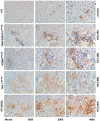Perilipin 5 and Lipocalin 2 Expression in Hepatocellular Carcinoma
- PMID: 30893876
- PMCID: PMC6468921
- DOI: 10.3390/cancers11030385
Perilipin 5 and Lipocalin 2 Expression in Hepatocellular Carcinoma
Abstract
Hepatocellular carcinoma (HCC) is one of the most prevalent and deadly cancers worldwide. Therefore, current global research focuses on molecular tools for early diagnosis of HCC, which can lead to effective treatment at an early stage. Perilipin 5 (PLIN5) has been studied as one of the main proteins of the perilipin family, whose role is to maintain lipid homeostasis by inhibiting lipolysis. In this study, we show for the first time that PLIN5 is strongly expressed in tumors of human patients with HCC as well as in mouse livers, in which HCC was genetically or experimentally induced by treatment with the genotoxic agent diethylnitrosamine. Moreover, the secreted acute phase glycoprotein Lipocalin 2 (LCN2) established as a biomarker of acute kidney injury, is also proven to indicate liver injury with upregulated expression in numerous cases of hepatic damage, including steatohepatitis. LCN2 has been studied in various cancers, and it has been assigned roles in multiple cellular processes such as the suppression of the invasion of HCC cells and their metastatic abilities. The presence of this protein in blood and urine, in combination with the presence of α -Fetoprotein (AFP), is hypothesized to serve as a biomarker of early stages of HCC. In the current study, we show in humans and mice that LCN2 is secreted into the serum from liver cancer tissue. We also show that AFP-positive hepatocytes represent the main source for the massive expression of LCN2 in tumoral tissue. Thus, the strong presence of PLIN5 and LCN2 in HCC and understanding their roles could establish them as markers for diagnosis or as treatment targets against HCC.
Keywords: AFP; HCC; LCN2; PLIN5; cancer; liver.
Conflict of interest statement
The authors declare no conflict of interest.
Figures









Similar articles
-
Lipocalin-2 (LCN2) regulates PLIN5 expression and intracellular lipid droplet formation in the liver.Biochim Biophys Acta. 2014 Oct;1842(10):1513-24. doi: 10.1016/j.bbalip.2014.07.017. Epub 2014 Jul 31. Biochim Biophys Acta. 2014. PMID: 25086218
-
Lipocalin-2 negatively modulates the epithelial-to-mesenchymal transition in hepatocellular carcinoma through the epidermal growth factor (TGF-beta1)/Lcn2/Twist1 pathway.Hepatology. 2013 Oct;58(4):1349-61. doi: 10.1002/hep.26467. Epub 2013 Aug 7. Hepatology. 2013. PMID: 23696034
-
Induction of lipocalin-2 expression in acute and chronic experimental liver injury moderated by pro-inflammatory cytokines interleukin-1β through nuclear factor-κB activation.Liver Int. 2011 May;31(5):656-65. doi: 10.1111/j.1478-3231.2011.02495.x. Epub 2011 Mar 16. Liver Int. 2011. PMID: 21457438
-
Lipocalin 2 (LCN2) Expression in Hepatic Malfunction and Therapy.Front Physiol. 2016 Sep 27;7:430. doi: 10.3389/fphys.2016.00430. eCollection 2016. Front Physiol. 2016. PMID: 27729871 Free PMC article. Review.
-
Markers for hepatocellular carcinoma.Immunol Ser. 1990;53:403-22. Immunol Ser. 1990. PMID: 1713067 Review.
Cited by
-
ELP6 and PLIN5 Mutations Were Probably Prognostic Biomarkers for Patients With Gastric Cancer.Front Med (Lausanne). 2022 Feb 9;9:803617. doi: 10.3389/fmed.2022.803617. eCollection 2022. Front Med (Lausanne). 2022. PMID: 35223903 Free PMC article.
-
Lipid-Independent Regulation of PLIN5 via IL-6 through the JAK/STAT3 Axis in Hep3B Cells.Int J Mol Sci. 2023 Apr 13;24(8):7219. doi: 10.3390/ijms24087219. Int J Mol Sci. 2023. PMID: 37108378 Free PMC article.
-
Perilipins at a glance.J Cell Sci. 2022 Mar 1;135(5):jcs259501. doi: 10.1242/jcs.259501. Epub 2022 Mar 9. J Cell Sci. 2022. PMID: 35260890 Free PMC article.
-
The influence of perilipin 5 deficiency on gut microbiome profiles in murine metabolic dysfunction-associated fatty liver disease (MAFLD) and MAFLD-hepatocellular carcinoma.Front Cell Infect Microbiol. 2024 Oct 14;14:1443654. doi: 10.3389/fcimb.2024.1443654. eCollection 2024. Front Cell Infect Microbiol. 2024. PMID: 39469452 Free PMC article.
-
Research advances of secretory proteins in malignant tumors.Chin J Cancer Res. 2021 Feb 28;33(1):115-132. doi: 10.21147/j.issn.1000-9604.2021.01.12. Chin J Cancer Res. 2021. PMID: 33707934 Free PMC article.
References
-
- Hashani M., Witzel H.R., Pawella L.M., Lehmann-Koch J., Schumacher J., Mechtersheimer G., Schnölzer M., Schirmacher P., Roth W., Straub B.K. Widespread expression of perilipin 5 in normal human tissues and in diseases is restricted to distinct lipid droplet subpopulations. Cell Tissue Res. 2018;374:121–136. doi: 10.1007/s00441-018-2845-7. - DOI - PubMed
Grants and funding
LinkOut - more resources
Full Text Sources
Miscellaneous

